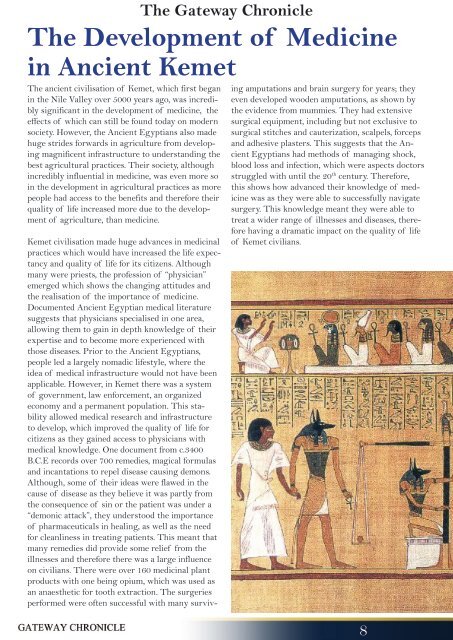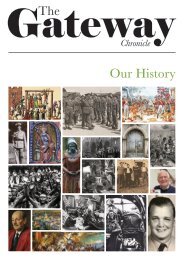You also want an ePaper? Increase the reach of your titles
YUMPU automatically turns print PDFs into web optimized ePapers that Google loves.
The <strong>Gateway</strong> <strong>Chronicle</strong><br />
The Development of Medicine<br />
in Ancient Kemet<br />
The ancient civilisation of Kemet, which first began<br />
in the Nile Valley over 5000 years ago, was incredibly<br />
significant in the development of medicine, the<br />
effects of which can still be found today on modern<br />
society. However, the Ancient Egyptians also made<br />
huge strides forwards in agriculture from developing<br />
magnificent infrastructure to understanding the<br />
best agricultural practices. Their society, although<br />
incredibly influential in medicine, was even more so<br />
in the development in agricultural practices as more<br />
people had access to the benefits and therefore their<br />
quality of life increased more due to the development<br />
of agriculture, than medicine.<br />
Kemet civilisation made huge advances in medicinal<br />
practices which would have increased the life expectancy<br />
and quality of life for its citizens. Although<br />
many were priests, the profession of “physician”<br />
emerged which shows the changing attitudes and<br />
the realisation of the importance of medicine.<br />
Documented Ancient Egyptian medical literature<br />
suggests that physicians specialised in one area,<br />
allowing them to gain in depth knowledge of their<br />
expertise and to become more experienced with<br />
those diseases. Prior to the Ancient Egyptians,<br />
people led a largely nomadic lifestyle, where the<br />
idea of medical infrastructure would not have been<br />
applicable. However, in Kemet there was a system<br />
of government, law enforcement, an organized<br />
economy and a permanent population. This stability<br />
allowed medical research and infrastructure<br />
to develop, which improved the quality of life for<br />
citizens as they gained access to physicians with<br />
medical knowledge. One document from c.3400<br />
B.C.E records over 700 remedies, magical formulas<br />
and incantations to repel disease causing demons.<br />
Although, some of their ideas were flawed in the<br />
cause of disease as they believe it was partly from<br />
the consequence of sin or the patient was under a<br />
“demonic attack”, they understood the importance<br />
of pharmaceuticals in healing, as well as the need<br />
for cleanliness in treating patients. This meant that<br />
many remedies did provide some relief from the<br />
illnesses and therefore there was a large influence<br />
on civilians. There were over 160 medicinal plant<br />
products with one being opium, which was used as<br />
an anaesthetic for tooth extraction. The surgeries<br />
performed were often successful with many surviving<br />
amputations and brain surgery for years; they<br />
even developed wooden amputations, as shown by<br />
the evidence from mummies. They had extensive<br />
surgical equipment, including but not exclusive to<br />
surgical stitches and cauterization, scalpels, forceps<br />
and adhesive plasters. This suggests that the Ancient<br />
Egyptians had methods of managing shock,<br />
blood loss and infection, which were aspects doctors<br />
struggled with until the 20 th century. Therefore,<br />
this shows how advanced their knowledge of medicine<br />
was as they were able to successfully navigate<br />
surgery. This knowledge meant they were able to<br />
treat a wider range of illnesses and diseases, therefore<br />
having a dramatic impact on the quality of life<br />
of Kemet civilians.<br />
8


















